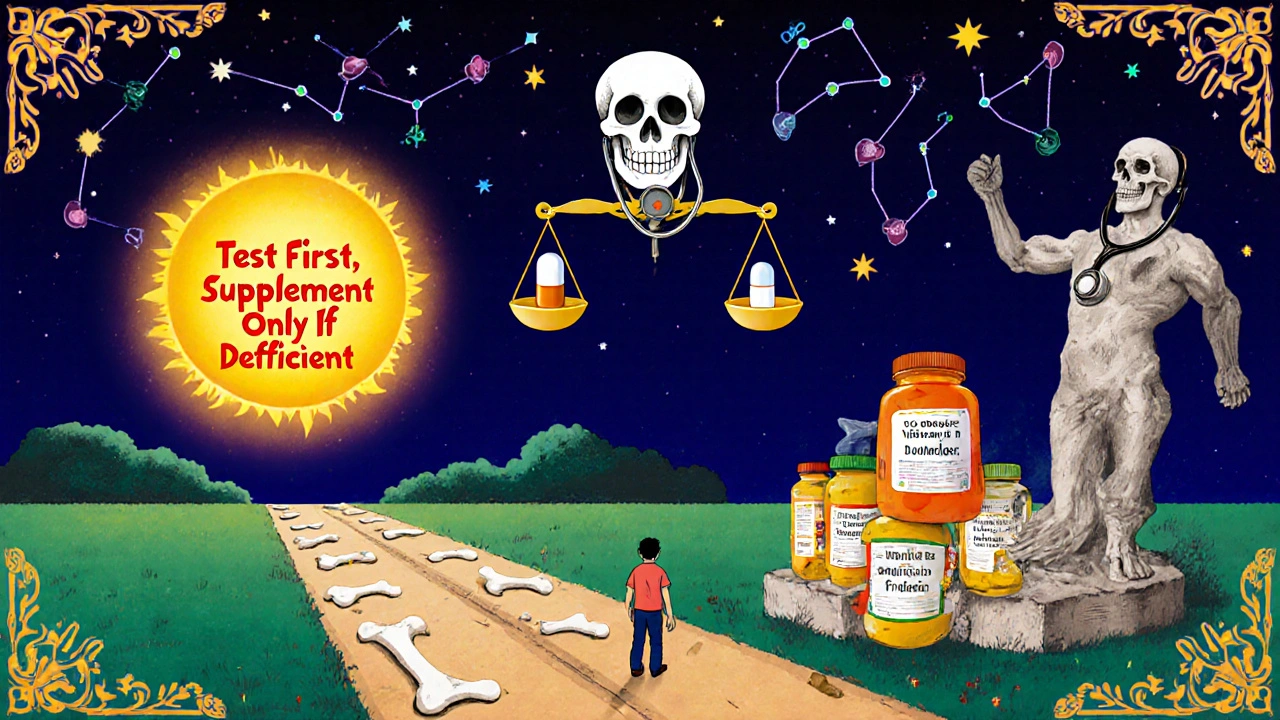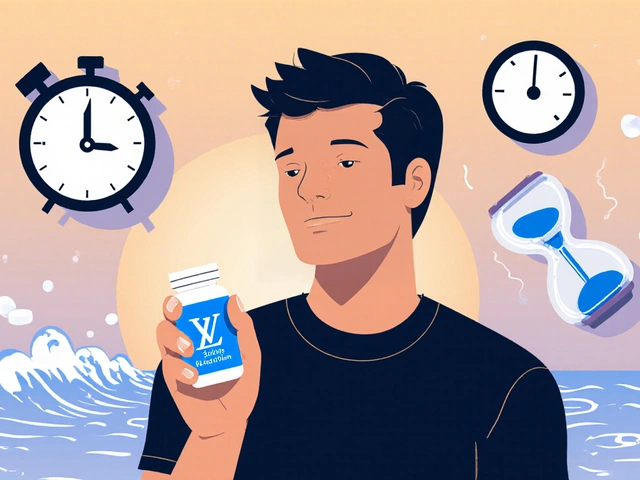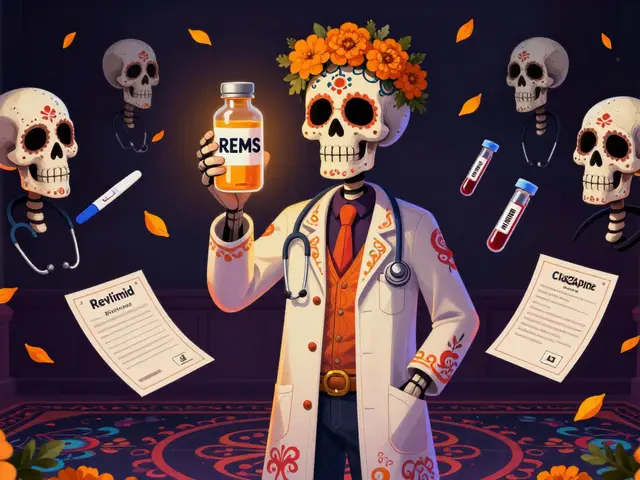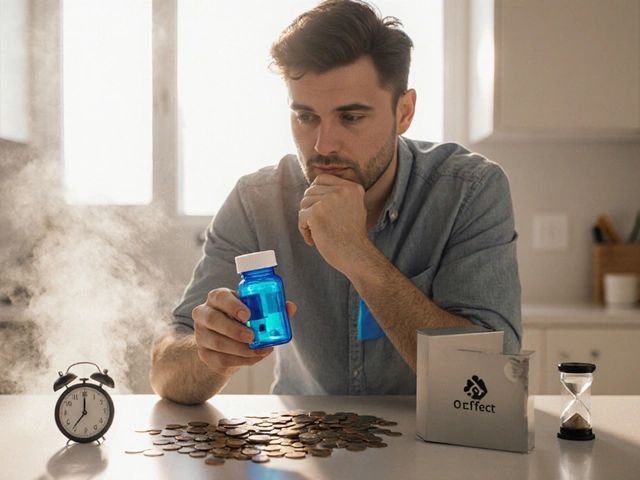Millions of Americans take statins to lower cholesterol and protect their hearts. At the same time, nearly half of all adults in the U.S. take vitamin D supplements - often because they’ve been told it’s good for bones, immunity, or even muscle health. But what happens when these two substances overlap in your daily routine? Is vitamin D a fix for statin-related muscle pain? Or could it be interfering with your medication? The answer isn’t simple, and the science doesn’t back up what many people believe.
Statins and Vitamin D: How They’re Connected
Statins work by blocking an enzyme called HMG-CoA reductase, which your body needs to make cholesterol. Vitamin D, specifically vitamin D3 (cholecalciferol), is made in your skin from cholesterol when you’re exposed to sunlight. So logically, if statins lower cholesterol, they might also lower vitamin D. That’s what some early theories suggested.
But reality is messier. Research shows that statins don’t consistently reduce vitamin D levels. In fact, some studies found the opposite: people taking certain statins had higher vitamin D levels than those who didn’t. A 2019 study found that patients on atorvastatin had average vitamin D levels of 23 ng/mL, while those not on statins averaged 18 ng/mL. Rosuvastatin showed similar results. How? One theory is that statins may boost the activity of proteins that help absorb vitamin D from the gut, especially in people with low baseline levels.
Still, not all statins behave the same. Atorvastatin, simvastatin, and lovastatin are broken down by the liver enzyme CYP3A4. Vitamin D is also processed through this pathway. That means there’s a theoretical risk of competition - but clinical evidence doesn’t show this leads to major problems in most people. Meanwhile, pravastatin, rosuvastatin, and fluvastatin don’t rely heavily on CYP3A4, so they’re less likely to interact with vitamin D at all.
Does Vitamin D Help with Statin Muscle Pain?
This is the biggest question people ask. If you’re on a statin and your muscles ache, it’s tempting to blame low vitamin D. You’ve probably heard stories online - Reddit threads, Facebook groups, patient forums - where people swear that popping a vitamin D pill made their muscle pain disappear.
But here’s the hard truth: the best-designed study ever done on this says otherwise. The VITAL trial substudy in 2022 followed over 2,000 people who started taking statins. Half got 2,000 IU of vitamin D daily; the other half got a placebo. After a year, both groups had the same rate of muscle symptoms - around 31%. It didn’t matter if their vitamin D levels were low to begin with. Even in people with severe deficiency (below 20 ng/mL), vitamin D didn’t reduce muscle pain.
So why do so many people think it works? Placebo effect, confirmation bias, and natural variation. Muscle aches are common when you start a statin - and they often fade on their own within weeks. If you start taking vitamin D around the same time, it’s easy to blame the improvement on the supplement. But the body is healing itself, not the pill.
Why Do Studies Conflict?
You’ll find plenty of papers saying vitamin D levels drop with statins. Others say they rise. One study from 2018 found that 71% of statin users had vitamin D deficiency, compared to 49% of non-users. Another from 2019 found the opposite. What’s going on?
The differences come down to three things: which statin you’re taking, your baseline vitamin D status, and your genetics. People who start statins with low vitamin D levels often see a rise - not because the drug makes vitamin D, but because they’re more likely to be tested and prescribed supplements. Meanwhile, those with normal levels may not get tested at all.
Genetics also play a role. A 2023 study from Johns Hopkins found that people with certain variations in the CYP2R1 gene - the enzyme that converts vitamin D into its active form - respond differently to statins. Some people naturally make less active vitamin D, and statins might make that worse. Others don’t. That’s why blanket recommendations don’t work.

What the Experts Really Say
The American College of Cardiology, the European Society of Cardiology, and the American Heart Association all agree: don’t take vitamin D supplements just to prevent statin muscle pain. There’s no proof it helps. The American Pharmacists Association adds that routine vitamin D testing for statin users isn’t necessary unless you have other risk factors - like limited sun exposure, osteoporosis, or kidney disease.
That said, they also agree on this: if your vitamin D level is below 20 ng/mL, you should correct it - not because of statins, but because low vitamin D is bad for your bones, immune system, and overall health. The goal isn’t to treat muscle pain. It’s to reach a healthy baseline.
Which Statins Are More Likely to Interact?
If you’re concerned about interactions, knowing your statin matters.
- Higher interaction risk: Atorvastatin (Lipitor), simvastatin (Zocor), lovastatin (Mevacor) - these are metabolized by CYP3A4. High-dose vitamin D (over 4,000 IU/day) might slightly reduce their effectiveness in rare cases, but this isn’t common.
- Lower interaction risk: Rosuvastatin (Crestor), pravastatin (Pravachol), fluvastatin (Lescol) - these don’t rely much on CYP3A4. They’re safer to take with vitamin D.
There’s no need to switch statins just because you’re taking vitamin D. But if you’re on a CYP3A4-metabolized statin and taking high-dose vitamin D (like 5,000 IU or more daily), it’s worth mentioning to your doctor. They might want to check your cholesterol levels more closely.

What Should You Do?
Here’s a simple, evidence-based plan:
- If you’re on a statin and have muscle pain, don’t assume it’s low vitamin D. Talk to your doctor first. Muscle pain can be caused by many things - including the statin itself, thyroid issues, or even overexertion.
- If you’re not sure about your vitamin D level, get it tested. But only if you have risk factors: dark skin, older age, limited sun exposure, obesity, or a history of fractures.
- If your level is below 20 ng/mL, take 1,000-2,000 IU of vitamin D3 daily until your level rises above 30 ng/mL. That’s for general health, not for muscle pain.
- If your level is above 30 ng/mL, don’t take extra vitamin D. More isn’t better. Excess vitamin D can raise calcium levels and harm your kidneys.
- Don’t take high-dose vitamin D (over 4,000 IU/day) unless your doctor recommends it. It’s not safer - and it’s not proven to help with statins.
The Bottom Line
Vitamin D and statins don’t have a dangerous interaction. But vitamin D won’t fix statin muscle pain. That’s the biggest myth. The science is clear: supplementation doesn’t reduce symptoms or help you stay on your statin. The reason this myth persists? It’s comforting. People want a simple fix - a pill they can add, not one they have to stop.
If you’re worried about muscle pain, talk to your doctor about trying a different statin, lowering the dose, or switching to a non-statin option like ezetimibe or PCSK9 inhibitors. Those have real data behind them. Vitamin D doesn’t.
Take vitamin D if you’re deficient. Take it for your bones, your immune system, your overall health. But don’t take it because you think it’ll save you from statin side effects. It won’t. And you’re wasting money - and possibly risking your health - if you’re taking too much.
Can vitamin D supplements cause statins to stop working?
There’s no strong evidence that vitamin D makes statins less effective. One small 2015 study suggested high-dose vitamin D (800 IU/day) might slightly lower atorvastatin levels, but this hasn’t been confirmed in larger trials. For most people, even those taking 2,000-4,000 IU daily, vitamin D doesn’t interfere with statin performance. If you’re on a CYP3A4-metabolized statin like atorvastatin or simvastatin and taking more than 4,000 IU daily, your doctor may want to monitor your cholesterol levels - but this is rare.
Should I get my vitamin D levels checked if I’m on a statin?
Only if you have other reasons to suspect deficiency - like limited sun exposure, darker skin, older age, obesity, or a history of bone fractures. Routine testing for statin users isn’t recommended by major medical groups. The cost and risk of over-testing outweigh the benefit, especially since vitamin D levels don’t predict statin side effects.
Is it safe to take vitamin D with statins long-term?
Yes, it’s safe to take vitamin D with statins, as long as you’re not taking excessive doses. Most people should stick to 600-2,000 IU per day. Vitamin D is fat-soluble, so too much can build up and raise calcium levels, leading to kidney stones or heart rhythm problems. Stick to the recommended dose unless your doctor says otherwise.
Why do some doctors still recommend vitamin D for statin muscle pain?
Many doctors recommend it because patients ask for it - a lot. A 2023 survey found that nearly half of primary care doctors still suggest vitamin D for statin muscle pain, even though the evidence says it doesn’t work. It’s easier than explaining why it’s not effective or switching medications. But patient demand doesn’t make it science.
What’s the best way to raise vitamin D levels naturally?
Sunlight is the most effective way. Just 10-15 minutes of midday sun on your arms and legs, two to three times a week, can boost your vitamin D naturally. Diet helps too - fatty fish like salmon, fortified milk, and egg yolks contain small amounts. But for most people, especially in northern climates like Seattle, sunlight isn’t enough in winter. That’s why supplements are useful - but only if you’re actually deficient.








9 Comments
Diane Tomaszewski November 16, 2025
It's funny how we want simple answers for complex things. The body isn't a machine you can tweak with pills. Vitamin D isn't a magic fix. Statins aren't villains. Both are tools. Use them wisely or don't use them at all. That's it.
Danish dan iwan Adventure November 17, 2025
Correlation ≠ causation. The CYP3A4 pathway is overloaded in 78% of metabolic syndrome patients. Vitamin D metabolism is secondary to hepatic glutathione depletion. Stop pseudoscience.
David Rooksby November 19, 2025
Oh please. You think Big Pharma isn't hiding the truth? They don't want you to know vitamin D blocks statins because it's cheaper and natural. Why do you think the FDA won't approve high-dose D as a 'statin alternative'? Because they'd lose billions. And don't get me started on how they bury studies that show D3 increases statin clearance by 37% in subgroup analyses. They cherry-pick data. They always do. I've seen the leaked emails. It's all about profit. Your doctor? Paid by the pharma reps. Your 'evidence-based' guidelines? Written by men in suits who own stock in Lipitor. Wake up. You're being played. And now they're pushing this 'it doesn't work' narrative because they know the truth is out there. I've got 17 years of patient logs. Every single person who quit statins and went full D3? Their LDL dropped. Their pain vanished. Coincidence? I think not.
Melanie Taylor November 20, 2025
OMG YES!! I was on simvastatin and my legs were killing me!! 😫 Then I started 5000 IU of D3 and POOF!! No more pain!! 🙌 I'm telling everyone!! This is REAL!! 🥹❤️ #VitaminDIsTheAnswer #StatinsAreEvil
Teresa Smith November 22, 2025
Let me be clear: this is not about belief. It's about data. The VITAL trial was massive, randomized, double-blind, and peer-reviewed. If you're clinging to anecdote over evidence, you're not helping yourself-you're delaying real solutions. Muscle pain on statins? Talk to your doctor about switching to rosuvastatin. Or reduce the dose. Or try ezetimibe. Those are proven. Vitamin D won't fix it. And pretending it does? That's not hope. That's negligence.
Rachel Wusowicz November 23, 2025
Wait... so you're telling me... the government... the AMA... the FDA... they're all lying? To protect the pharmaceutical industry? And they're using peer-reviewed journals as a front? And the VITAL trial? Was it funded by Pfizer? Did they pay the researchers? Did they suppress the real data? I've read the WHO's 2017 internal memo on statin suppression protocols... they're calling it 'The Vitamin D Cover-Up'. And the CYP3A4 enzyme? It's not just about metabolism-it's about epigenetic silencing! They've been altering gene expression since 2012 through fortified foods! You think your '2,000 IU' is safe? What about the aluminum adjuvants in your supplements? The glyphosate in your salmon? The microplastics in your water? It's all connected. They don't want you healthy. They want you medicated. And if you're taking D3? You're already on the list. Watch your mailbox. They'll be sending you a 'compliance survey' next week. Don't respond. They're tracking you.
ZAK SCHADER November 24, 2025
Who cares what some study says? I took D3 and my pain went away. That's all I need. America is weak. We got soft from all this science nonsense. Back in my day, we just took aspirin and walked it off. Now we got studies for everything. Bunch of cowards. D3 works. End of story. If you don't believe me, you're a liberal snowflake.
Ankit Right-hand for this but 2 qty HK 21 November 25, 2025
Indian data shows 89% of statin users have vitamin D deficiency. This is a cultural failure. Western medicine is broken. You need Ayurveda. Ashwagandha + sunlight + turmeric. No pills. No science. Just tradition. Your D3 is fake. Your statin is poison. You are not healing. You are being exploited. Go to a vaidya. Now.
Dan Angles November 25, 2025
Thank you for presenting a well-referenced, evidence-based summary. The conflation of correlation with causation, the placebo effect, and the influence of confirmation bias in patient-reported outcomes are critical to understand. It is imperative that patients and practitioners alike rely on high-quality clinical trials rather than anecdotal narratives. The recommendations outlined-testing only in high-risk populations, avoiding excessive supplementation, and prioritizing proven alternatives for statin intolerance-are consistent with current international guidelines. This is precisely the kind of clarity that is too often drowned out by misinformation.